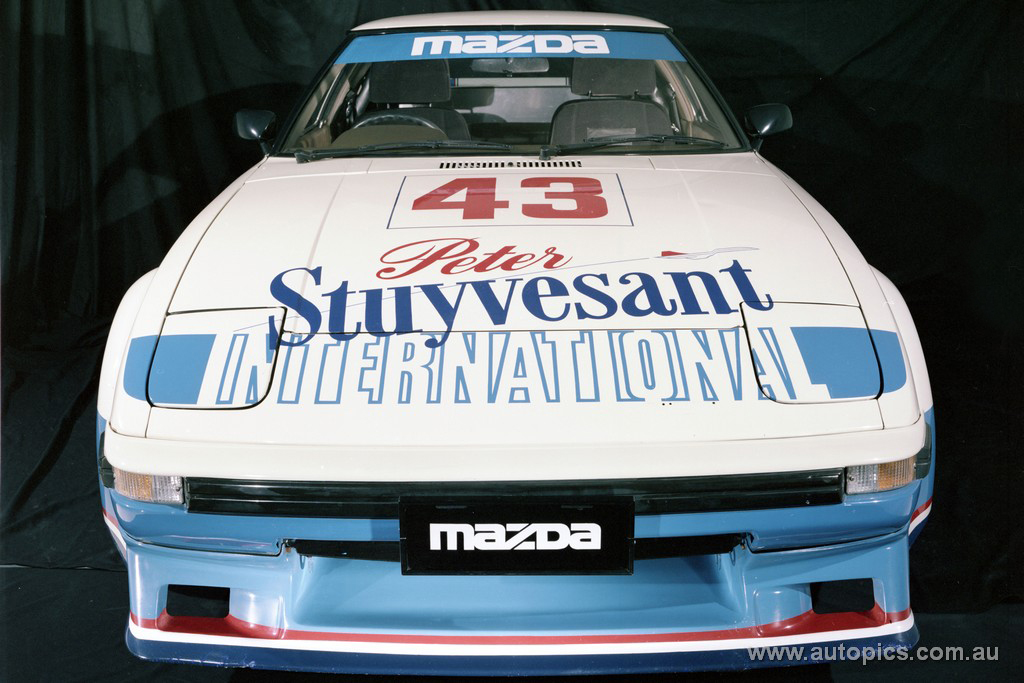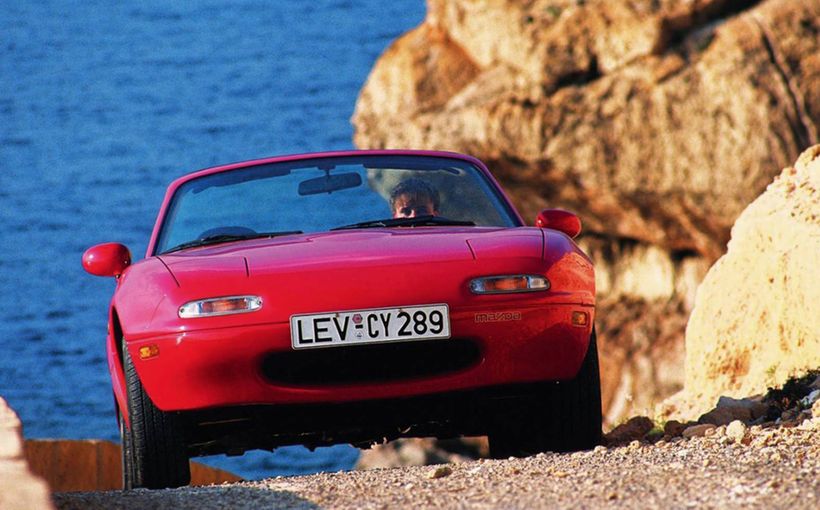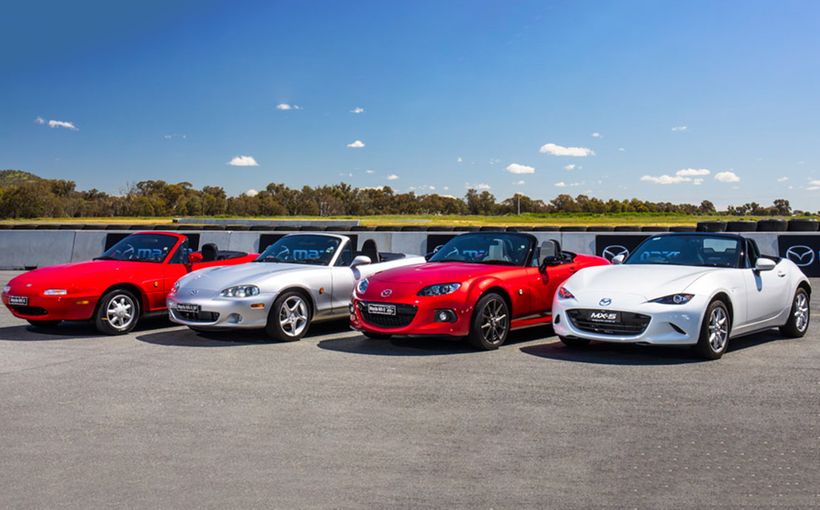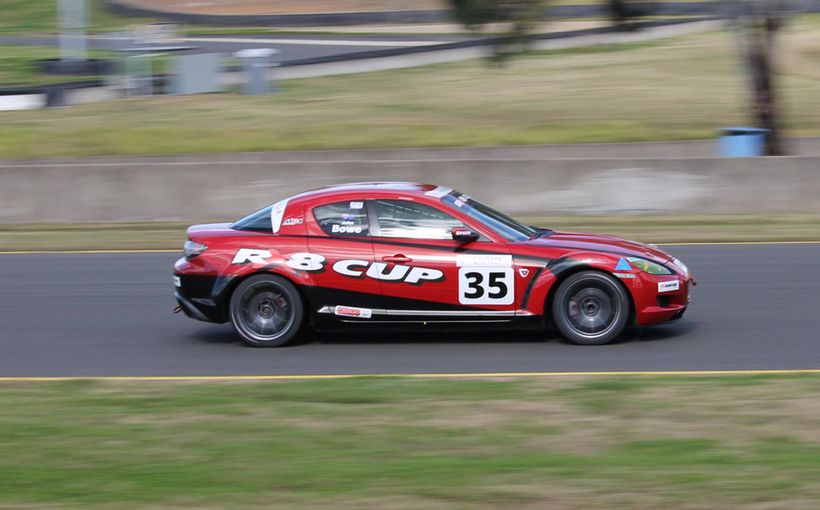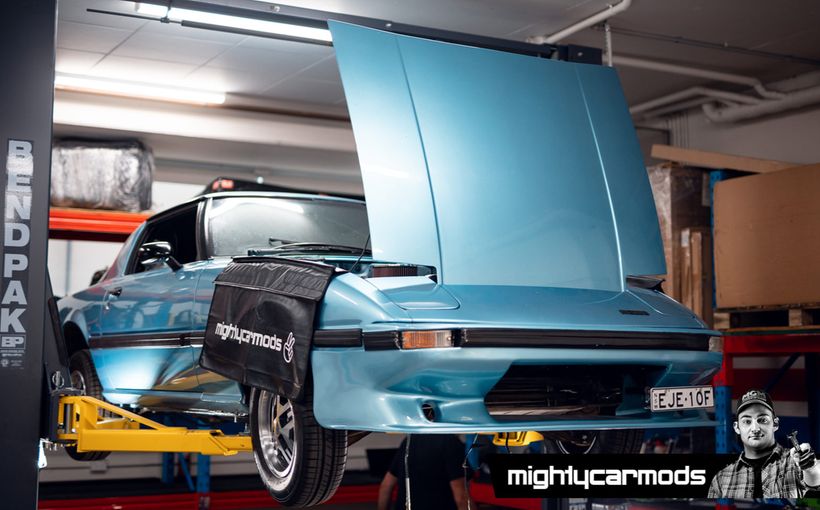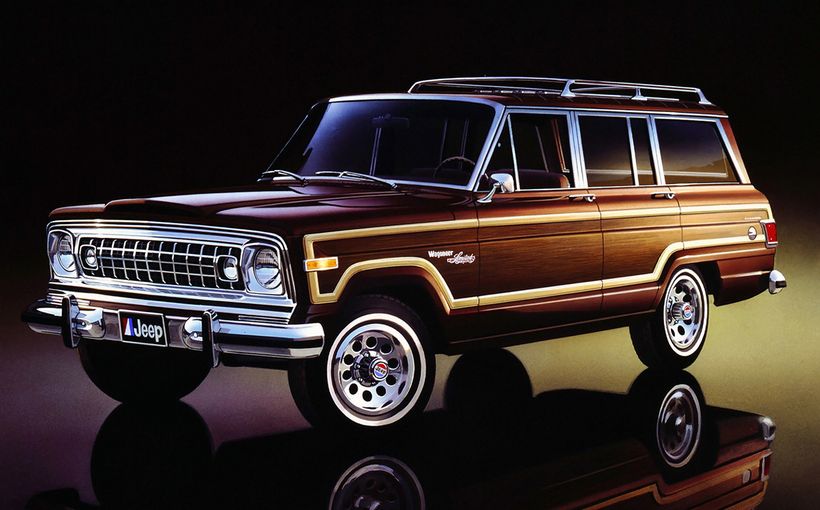MAZDA RX-7: Australia’s most controversial Group C touring car
By
MarkOastler -
01 September 2014

Face of the future. Long-time Ford hero Allan Moffat’s surprise switch to a Mazda RX-7 works drive was guaranteed to polarise race fans and create its own brand of drama and excitement. Moffat’s four-season campaign in the rotary-powered rocket was a thrilling era in Australian touring car racing.
The Production Touring - Group C era (1973-1984) ignited as many confrontations in the courtroom as it did on the race track, but no car created more controversy, heated debate and political division during this volatile time than the Mazda RX-7.
From the moment its entry was proposed late in 1978, the little rotary-powered sports coupe from Japan challenged traditional thinking on what an outright contender in 1980s touring car racing could be. And that was enough to trigger a farcical political stoush over its acceptance, which played out from late December 1979 to January 1981.
During that volatile period, Australian Mazda distributors and their new racing figurehead Allan Moffat battled the Confederation of Australian Motor Sport (CAMS) in seeking approval to race the RX-7 as an outright Group C contender.
The new Mazda sports coupe had already gained FIA approval to compete as a Group One touring car. Even so, critics claimed that it was a sports car that should never have been granted approval to compete against traditional two and four-door sedans.
At the root of the Australian controversy was Mazda’s request to use peripheral porting on its 12A rotary engine. This was a high performance factory modification used only on Mazda competition engines as it was not suitable for road car applications due to unacceptable noise and exhaust emissions.
It simply meant that the inlet ports were located on the outside or ‘periphery’ of the 12A’s two rotor housings directly above the exhaust ports, as opposed to their usual side port location in the end plates of the engine. This provided a more direct flow of fuel/air mixture into the rotor housings from the carburettor, which allowed the engine to breathe better and produce more power.

What all the fuss was about. Note how the peripheral ports are mounted straight above the exhaust ports on the rotor casings, providing a shorter and more direct inlet path from the carburettor. The 12A’s pair of 573cc rotors had a combined capacity of 1146cc but when subjected to the FIA’s engine parity formula (which doubled the cubic capacity of rotary engines) resulted in a nominal 2292cc. With the more restrictive conventional ports, this engine was a strong competitor in the under 3.0 litre class. Peripheral porting, though, raised it to the outright division. Note the tiny oil sump. This remarkable engine was so small and light it was claimed you could carry it onto a plane as hand luggage!
In effect, it was no different to fitting larger inlet valves and a hotter camshaft to a conventional reciprocating engine for competition use. But a rotary engine doesn’t have valves or camshafts - and therein lay the fundamental problem.
It’s human nature to fear what you don’t understand and here was a proposal that called for a significant divergence from traditional thinking, not only for Allan Moffat’s racing future but also potentially for many other drivers and the overall good of the sport.
As you will discover in this story, Australian motor sport came within a chopstick of losing one of its best drivers in one of the sport’s most exciting and polarising cars, with the backing of one of the most enthusiastic manufacturers ever to be involved in the sport.
The fact that the peripheral port RX-7 was finally approved in early 1981 is a moment in time we should all be grateful for, as Allan Moffat and Mazda turned on some of the best touring car racing ever seen in this country.

The Moffat RX-7 era brought back the ‘David vs Goliath’ glory days of the early 1970s, when Holden’s smaller and less powerful Torana XU-1s were nipping at the heels of the larger and more powerful Falcon GT-HOs. On-going development turned the RX-7 into a giant killer that was more than a match for the V8s on most tracks – except for that big, steep hill at Bathurst.
1978-1981: Not your typical port in a storm
In December 1978, Mazda Motors approached Allan Moffat to spearhead its application to gain acceptance for the RX-7 in Aussie touring car racing.
At that time, Moffat had just been advised that the Ford dealer network which had been backing his two-car XC Falcon race team for the past two seasons was withdrawing its commercial support.
Clearly the opportunity to lead a factory-backed Mazda attack was too good to refuse, as it represented an opportunity for Allan Moffat Racing to head in an exciting new direction with a new manufacturer that could secure his racing future.
Moffat knew this represented a formidable challenge, even though he was confident that given the RX-7’s light kerb weight of just over 1000 kgs, near perfect 51:49 weight distribution, low centre of gravity, slippery aerodynamics, excellent handling agility and minimal tyre wear, it could apply plenty of pressure to the V8s with enviable reliability.

In January 1982, Moffat drove this IMSA RX-7 to a great victory in the GTU class (Under 2.5 litre) and sixth outright in the annual Daytona 24 Hour race in the USA. With superb preparation by the same team which finished 1-2 in the 1981 IMSA championship, Moffat’s winning co-drivers were top female racer Kathy Rude and reigning IMSA champion Lee Mueller. The peripheral port rotary ran faultlessly for 24 hours and according to the mechanics could have done it all over again – a welcome relief for Moffat after many years of brittle and broken Ford V8 engines.
In April 1979, Moffat flew to the USA to get his first taste of a peripheral ported RX-7 in test sessions conducted at the Kent circuit in Seattle. Moffat completed 700 kms of testing at full racing speeds and was astonished that the mechanics did not once lift the bonnet. It was something he didn’t forget at Bathurst later that year, when he blew up six Ford V8s in one weekend!
For Moffat’s second visit to Kent, the test car was fitted with a selection of specially developed Goodyear tyres. The RX-7 not only ran faultlessly again, but Moffat was also impressed by the car’s conservation of its tyres, even some very soft compounds.
Given the huge cost of four new racing tyres in Australia, it was further proof for Moffat that the RX-7 could greatly reduce the cost of touring car racing and add some much needed stability and direction for a sport that was heading into a new and uncertain era.
On December 10, 1979 CAMS announced its provisional approval of the Mazda RX-7 with peripheral porting, to compete in the over 3.0 litre class as an outright contender in 1980.
Given the gravity of the situation, CAMS CEO John Keeffe recommended a two-week moratorium on its decision to allow any interested parties to voice their support or to raise any concerns.
Objections were raised by different parties but by far the most vocal was Sydney Toyota dealer Peter Williamson, who since 1977 had been racing a Celica with great success in the 2.0 litre class.
Williamson claimed the allowance of peripheral porting would lead to a mass withdrawal of entrants from the small car classes as “all they (the viewing public) will see is a Mazda RX-7 being unrealistically superior to a lot of other cars against which it competes in the market place.”

Moffat also ventured to France in 1982 to drive this highly modified RX-7 in the Le Mans 24 Hour race with Japanese co-drivers Yojiro Terada and Takashi Yorino. The wild, whale-tailed factory racer competed in the GTX category for modified production cars. Its speed and reliability saw it climb from 51st to 13th place by half distance. An outright top ten finish was in their sights until the gearbox needed replacing with six hours remaining. Even so, they finished strongly in 14th outright and sixth in class. And the Mazda's little rotary engine ran without a hitch for almost 4,000 kms - or four Bathurst 1000s non-stop.
On reflection, the basis of Williamson’s argument had more than a touch of hypocrisy about it, given that he was dominating the 2.0 litre class battle in a twin-cam
Celica GT model which was not sold in Australia by Toyota. If there was ever a car that was “unrealistically superior to a lot of other cars against which it competes in the market place” then he was driving it!
However, the Mazda proposal also had many supporters including Holden hero Peter Brock, who after two seasons of Holden domination needed someone to beat. Most of the track promoters were also on side, along with the motor sport press and the public, too.
However, in a remarkable back-flip, CAMS reversed its decision and on December 22, 1979 declared that the peripheral port RX-7 would not be allowed to race after all.
After further deliberations during the following five months, the governing body changed its mind again on the issue and declared on May 26, 1980 that the peripheral port RX-7 would in fact be allowed to race. Yet only days later on June 7, CAMS changed its mind again, rejecting the Mazda proposal and stating that the peripheral port issue had been “deferred indefinitely”.
What a circus! The Mazda distributors and Allan Moffat could have been excused for walking away from Australian motor sport in disgust at their treatment by the sport’s governing body. What most people didn’t know, though, was that CAMS’ dogged resistance only strengthened Moffat's and Mazda’s resolve.
In the following months, Moffat single-handedly ensured Sandown Park was standing room only when he guest-drove a HDT Commodore to second place behind team mate Peter Brock at the 1980 Sandown 400 in September.

After CAMS rejected Mazda’s proposal again in June 1980, Moffat had a disastrous Bathurst 1000 in October aboard this XD Falcon which was plagued by chronic engine problems. It added weight to his argument that the RX-7 could provide welcome relief for privateers from the crippling costs of running Ford and Holden V8 touring cars. However, history shows that many privately entered RX-7s did not share the impressive reliability of Moffat’s factory cars.
At Bathurst a few weeks later, he turned up with an ill-fated XD Falcon which his team had hastily put together. It lasted only three smoky laps in the race before retirement, leaving Moffat with nothing but another pile of broken V8 engines and repair bills to show for it.
The governing body’s inner turmoil also came to a head during this time, with an important internal restructure that paved the way for a final assessment of the peripheral port issue.
To assist CAMS in its deliberations, Mazda Motors imported from America a semi-works car owned by Washington’s Jerry Wright Racing.
It was the same RX-7 that Moffat drove in the Daytona 24 Hour race earlier that year (which a co-driver crashed out of the event) built to the IMSA regulations which were very similar to what was being proposed for the local Group C cars.
Moffat drove the car in the final round of the Australian Sports Sedan Championship at Sandown Park in December. It was simply to prove that the peripheral port RX-7 wasn’t the world beater its critics said it was. Even Peter Brock had a drive to ensure there was no sand-bagging going on.
On December 19, Mazda Motors lodged its final application with CAMS. Finally, in January 1981, the governing body announced that the peripheral port RX-7 had been approved to compete as an outright contender in Australian Group C touring car racing. There would be no more rejections.
The long, bloody political battle was over, but before Mazda and Allan Moffat Racing could race against the V8s they first faced a race against time to build a new race car from scratch.
Given the late approval, there was no chance of taking part in the 1981 Australian Touring Car Championship (ATCC), so the target for launch was the Hang Ten 400 at Sandown in September – the traditional shakedown race for the all important Bathurst 1000 in October.

Moffat’s new RX-7 taking shape at his Melbourne workshop in 1981. The long out-of-print Australian Motor Racing magazine provided detailed coverage of the build program during the countdown to its debut competition debut at Sandown in September.
Building the car
Consideration had been given to importing factory-built race cars from Japan, but following the lengthy delay in seeking approval to race the peripheral port RX-7, it was decided to build a new car from scratch at Moffat’s Melbourne workshop.
That way the car could be tailored to suit the local Group C rules from the start, commencing with a bare steel body that was supplied in primer and without any seam sealants and sound deadening compounds to save weight.
The unitary bodyshell was fully seam-welded and strengthened before a rigid but lightweight roll cage made from 48mm diameter aluminium tubing with 3mm wall thickness was bolted in firmly at key attachment points throughout the cabin. These points were chosen also to maximise chassis rigidity for consistent handling and suspension tuning.
Mounted beneath the rear floor area under the glass rear hatch was a 130-litre ATL aircraft-grade fuel cell, featuring the latest dry-break refuelling hardware in a drop tank design that carried the fuel load as low as possible to improve handling.
As it was impractical to have the dry-break fillers mounted beneath the big rear spoiler or on the rear quarter panels, they were mounted in the boot area under the glass hatch which had to be opened and closed by a crew member when refuelling the car during pit stops. This was later changed with access holes that didn't require the hatch to be raised.
As an extra fire safety precaution, the driver’s compartment was sealed off from this boot area by a clear sheet of tough polycarbonate.

Another view of Moffat’s RX-7 bolted to its ‘rotisserie’ frame which allowed the car to be rotated and then locked off at any angle for work to be performed. Note the big fiberglass wheel flares to shroud 10-inch wide Goodyear race tyres custom-made for the RX-7 program.
Under the bonnet was Mazda’s tiny twin-chamber 1146cc 12A rotary engine hand-built for competition use by the factory in Japan, with its peripheral ports fed by a single 48mm IDA (downdraught) Weber twin-choke carburettor mounted on a pair of elegantly simple cast-
aluminium inlet runners.
The tuned exhaust system, which ran the full length of the car with a large single outlet under the rear bumper bar, emitted a shrieking, ear-splitting buzz that sounded even more ferocious than the swarm of angry bees that characterised the previous bridge-port 12A rotaries.
Power from these factory-supplied engines was quoted at around 260-270 bhp @ 7500-8000 rpm. Redline was set at 8500 rpm but revs could stretch to a screaming 9000 rpm with safety.
A five-speed close-ratio gearbox and competition clutch fed engine power to a coil-sprung live rear axle with a choice of up to seven diff ratios from 3.5 to 5.5:1, located by rose-jointed upper and lower trailing arms and a Watts linkage with an anti-roll bar. Front suspension featured beefed up MacPherson struts with uprated coil springs and an anti-roll bar.
Moffat’s first Mazda came together more like a ‘kit car’ with the major components like engines, gearboxes, rear axle assemblies, springs and shocks being shipped directly from the factory in Japan or through US sources. It was thought this would revolutionise touring car construction.
Even the powerful disc brakes at each corner were supplied as complete assemblies direct from the factory with large ventilated rotors and Sumitomo-branded callipers ready to bolt straight on.
These were hidden within modular three-piece BBS cast magnesium alloy wheels; 16 inches in diameter by 9.0 inches wide at the front and the maximum allowable 10 inches width at the rear. These beautifully made German wheels were super light yet very strong, fitted with custom-made Goodyear race tyres through Moffat’s strong connections with the famous American tyre maker.

Another view of the freshly painted Moffat RX-7 getting its big rear spoiler fitted. The aerodynamic body kit designed for the Group C car looked great and was very effective.
In true Group C fashion, these fat wheels and tyres protruded a long way outside the standard bodywork, so were fully shrouded in large wheel arch flares made from lightweight glass fibre composites.
The four flares were part of a Group C body kit homologated for use on the RX-7 to improve its aerodynamic performance at race speeds.
As Moffat’s car was reportedly the first 1981 four wheel disc brake model to race in Australia, it looked slightly different to other (bridge port) RX-7s that were already competing here which were based on the limited edition Mirage model released in 1980.
Up front was a more aggressively-styled spoiler with a large splitter, big central air intake to cool the engine’s Nippondenso-brand racing radiator and smaller inlets on either side to feed cooling air to the front brakes.
Mounted on the tail was a big air dam-type spoiler designed to harness the air flowing over the roof and down the sloping rear glass, to provide downforce on the rear tyres to improve traction and high speed stability.
Given that this big ‘duck tail’ first appeared in 1981, it was interesting to watch the development of similar devices on Commodore, Falcon and Nissan Bluebird rivals, which all had evolved into very similar designs by the final year of Group C in 1984. Clearly, it worked.

Moffat showing how close that big front splitter sat to the road surface as he shaves the bitumen at Murray’s Corner cutting some hot laps in practice for the 1981 Bathurst 1000. Many fans believe Moffat and his Le Mans winning co-driver Derek Bell were on course to win this race on debut had it run its full 163-lap distance. And wouldn’t that have upset the boys on the hill!
1981
In early September, Allan Moffat Racing joined with Mazda and new tobacco sponsor Peter Stuyvesant International in unveiling the team’s brand new RX-7 at a lavish black-tie function held at Melbourne’s Hilton Hotel. At the time it was heralded as the most spectacular race car launch Australia had seen.
Moffat debuted the Peter Stuyvesant RX-7 at the annual Hang Ten 400 at Sandown Park on September 13, 1981. CAMS and V8 rivals would have been relieved to see that the approval of peripheral porting had not suddenly turned the 3.0 litre class competitor into the V8 killer they had feared. Even so, the little car showed great potential.
Moffat’s best qualifying time was more than four seconds off Dick Johnson’s pole position time, which placed him 14th on the grid behind a herd of V8s. However, he made a great start to pass five cars on the first lap and after 400 trouble-free kilometres had climbed his way to fifth place.
It was a mighty impressive performance for a brand new and relatively undeveloped car in its first race, particularly as it finished one place ahead of the 3.5 litre JPS
BMW 635 CSi driven by Allan Grice which had been competing since the start of the season.
The BMW and Mazda would face off for class honours in the newly created six cylinder/rotary class at the Bathurst 1000 in October, where the RX-7 turned in a remarkable debut on the Mountain that really opened people’s eyes to its outright race-winning potential in endurance racing.
The Peter Stuyvesant Mazda became the first non-V8 powered car to qualify for the prestigious Hardie’s Heroes Top 10 qualifying shoot-out. On a rain-soaked track, Moffat did a brilliant job to take the fifth fastest time before finishing third outright in the race with British co-driver Derek Bell.

Mazda rotary tuning ace and race driver Barry Jones was a prominent RX-7 privateer. He teamed up with Alan Jones for the 1982 endurance season as part of the retired F1 champ’s multi-car team. Although ‘The Jones Boys’ scored a first-up win at Amaroo Park’s CRC 300, the rest of the season was plagued by transmission problems. Here Alan Jones leads his team’s troublesome XE Falcon at Bathurst in 1982. The Falcon entered for Bob Morris/John Fitzpatrick broke a wheel, crashed heavily in practice and didn’t start the race. The Jones/Jones Mazda retired with gearbox failure.
Moffat and Bell could well have won the race had it not been shortened to only 120 of its scheduled 163 laps due to a huge multi-car crash. At the time the race was red-flagged, the RX-7 had completed its last scheduled pit stop and was running hard and fast behind two XD Falcons which were both requiring lengthy final pit stops for fuel and were claimed to be in declining health.
Moffat and his Mazda finished off their first season with an outright win at the final round of the 1981 Endurance Championship at Queensland’s fast and flowing Surfers Paradise Raceway in November.
Again the little car was outgunned by the V8s in qualifying, but come the race he steadily climbed to second place which became first when race leader Peter Brock in his Commodore was penalised 60 seconds for needing a push-start from the HDT crew after a pit stop. A first outright win for the RX-7 after only three races already was an ominous sign for his V8 opponents.
Moffat’s car was then treated to a great Christmas present from Mazda engineers in Japan, when it was flown to the Mount Fuji race circuit near Tokyo for some intensive development work focused on the car’s chassis and suspension tuning.
Moffat was staggered by the expertise and calm efficiency of the factory engineers, who assisted in making considerable improvements to the Australian-built car’s lap times. Valuable lessons learned at Mount Fuji would be reflected in Moffat’s first full season of touring car racing in 1982, in which his V8 opposition would get a big fright.

Sydney-based driver Terry Shiel was another prominent RX-7 privateer during the Group C years. Although he won Amaroo Park’s AMSCAR touring car series in 1983 he was out of luck at Bathurst, recording four retirements from four starts due to a variety of mechanical problems.
1982
Proof of the gains being made in the RX-7 was Moffat’s qualifying time at the opening round of the 1982 ATCC at Sandown Park in February, where he knocked almost two seconds off his fastest lap from the Hang Ten 400 only six months before.
The RX-7 was clearly in its element on fast, flowing circuits where the rotary could stay in its high rpm power band, rather than tracks with slower turns that exposed its inherent lack of torque against the raw grunt of the V8s.
Moffat staggered everyone in the fifth round at the high-speed Lakeside track in Queensland. He took only three laps to nail pole position with a time 0.1 sec under local Ford V8 hero Johnson’s lap record, before powering away to a commanding win in the 35-lap race with a new lap record along the way.
The gasps of despair from V8 rivals were even louder at the eighth and final round at the fast and flowing Surfers Paradise Raceway, where Moffat again claimed pole position - this time a whopping 1.4 seconds under Johnson’s lap record. He again set the fastest race lap on his way to another impressive victory over the V8s.
Moffat and Mazda had really upset the apple cart. A rising chorus of bitterness claimed that he had done a magnificent ‘con job’ on CAMS in getting the peripheral port Mazda accepted as a touring car.
This ill-feeling was evident at the post-race prize giving at Surfers, where second-placed Allan Grice claimed he had won the ‘touring car’ race in his Commodore while Moffat was the winner of the ‘sports car’ section!

Phil Alexander was a long time Mazda exponent and one of many private entrants to run the peripheral port RX-7. Here his brightly coloured Mazda is on its way to 10th place in the 1982 Bathurst 1000 with versatile co-driver Ron Gillard. Alexander/Gillard would go one better at Bathurst in 1983, finishing ninth.
Moffat finished third overall in the 1982 ATCC which fell again to Dick Johnson’s Tru-Blu
XD Falcon. His dazzling giant-killing performances continued in the 1982 Australian Endurance Championship, too, comprising five long distance races that included dual titles for manufacturers and drivers.
Although Nissan’s steadily improving Bluebird Turbo scored the most manufacturer points,
Moffat and Mazda were electric in the AEC, winning the Sandown 400 km, Surfers Paradise 300 km and Adelaide 300 km rounds to wrap up the driver’s title in convincing style.
Bathurst was the major disappointment of the year, as he failed to improve on the team’s stunning third place finish on the Mountain in 1981.
Moffat and Japanese Mazda ace Yoshimi Katayama were looking strong in the early running but the pace was so hot the car ran out of front brakes in the afternoon, requiring an agonising 13-minute stop to replace the front pads in newly homologated brakes which had not been trialled at Bathurst.
They finished sixth and many laps down on the winning Brock/Perkins
HDT SS Commodore. Overall it was not a good Bathurst race for Mazda, as the 10 RX-7s entered mostly by private teams suffered numerous problems, with only five running at the end.

Allan Moffat on his way to second outright with Japanese Mazda star Yoshimi Katayama in the 1983 Bathurst 1000. By this stage Moffat had more than one team car at his disposal, to provide a choice of right-hand drive or left-hand drive chassis to suit different circuits. As Mount Panorama featured mostly left-hand corners, the LHD car was used. With the driver sitting on the left, they could place the car more accurately through the turns and reduce the effects of lateral weight transfer under cornering loads.
1983
This year was really the peak of the RX-7 program. Moffat won the 1983 ATCC, which was his fourth national title and his first since switching to Mazda. Nissan’s Bluebird Turbo also emerged as a major threat this year, with factory ace George Fury finishing second and only six points behind the Mazda star in the overall tally.
The pro-V8 critics had never been more vocal, too, claiming that Australia’s premier touring car battle was ‘turning Japanese’ and that it was the first time a ‘sports car’ had won the title.
The growing anger towards CAMS in allowing the balance of power to tip so far in favour of these small and increasingly potent Japanese cars was palpable. What the critics didn’t realise was that history would judge this volatile period as one the greatest in local touring car history.
Moffat’s superb driving, factory-backed preparation and sharp race tactics took full advantage of the Japanese car’s many strengths and exploited the weaknesses in others, winning four rounds and setting five new lap records along the way. He thoroughly deserved his fourth title.
Without doubt Moffat’s greatest victory that year – and one of the best of his career – was at WA’s Wanneroo Park. To counter the V8 advantage on the long steep climb at the back of the circuit, Moffat started the race with a low fuel load and soft tyres to build a crucial buffer before rocketing into pit lane for an F1-style splash of fuel needed to see him through the remaining laps. He re-joined in third and quickly hunted down Fury’s Nissan and race leader Brock to win. What a pro!

NSW privateer Peter McLeod was arguably the works team’s unofficial back-stop due to consistent driving and impressive reliability. McLeod claimed the 1983 Australian Endurance Championship and finished third in the 1984 ATCC. His best Bathurst 1000 result in the RX-7 was fifth in 1983. Ironically, McLeod would become a Bathurst winner four years later in a Brock-Mobil V8 Commodore its team described as “a bucket of bolts”.
CAMS controversially introduced new technical freedoms for different makes and models to even up the competition in the six-round Australian Endurance Championship. Moffat and Mazda had successfully lobbied that the RX-7 needed more grunt to get up the hill faster at Bathurst, so CAMS approved use of the larger and more powerful 13B engine (as fitted to USA cars) with fuel injection. His V8 rivals were astonished, to say the least.
Unlike the previous year, Moffat competed in only two AEC rounds. Armed with his new injected 13B engine, he ran away to an easy win in the Sandown 400, prompting rivals to claim that CAMS had just handed a Bathurst win to Moffat and Mazda on a silver platter.
However, the new engine did not produce the big performance gain he needed to finally topple the dominance of V8 power at Mount Panorama. Moffat and Katayama finished in second place, beaten by only one V8 – the Brock/Perkins/Harvey HDT SS Commodore.
Moffat’s absence from most of the 1983 AEC didn’t stop Mazda’s snowball of success in endurance racing, with RX-7 privateer Peter McLeod claiming the driver’s title without winning a round. It was a result of dogged consistency and reliability, which is what the series was really all about. McLeod’s success also contributed to Mazda finishing as equal champions with Holden in the manufacturer’s battle for bragging rights.

Allan Moffat wasn’t the only Falcon V8 loyalist to dump Ford in favour of Mazda. Evergreen touring car veteran Murray Carter drove this nicely presented RX-7 in 1983-84, but luck still deserted the popular battler at Bathurst. Poor old Murray didn’t complete one lap in the 1984 Bathurst 1000, after getting punted so hard from behind on Conrod Straight his car ended up in an orchard!
1984
This was the last year of Australia’s home-grown Group C touring car category. As a result it was also the last year we would see both Mazda and its RX-7 in action, as the Japanese manufacturer had no suitable replacement to suit the new FIA Group A regulations coming for 1985.
Even so, like the previous year the 1984 ATCC was another absorbing contest. With the seven-round series producing six different race winners, Dick Johnson in his thundering green XE Falcon claimed his third national title which tipped the balance back in favour of the embattled V8s for Group C’s curtain call.
The Ford hero’s job was made easier given Moffat’s early exit from the title fight. The defending champion finished third at Sandown’s opening round before claiming pole position for round two at Symmons Plains in Tasmania.
However, Moffat suffered an embarrassing race retirement after leaving the RX-7’s special ‘car bra’ on for too long while warming up his engine in the icy conditions. The rotary overheated and died before a lap had been completed.
Moffat then won convincingly again in WA, but ended up in hospital after a big shunt in the wet round four battle at Surfers Paradise. Contact with a lapped car sent him firing off the circuit at high speed across wet grass and head-first into a hidden tree stump on the outfield.

Moffat’s last season with the RX-7 in 1984 produced mixed results, after suffering a heavy shunt at Surfers Paradise which ended his ATCC title defence. The RX-7 had reached the peak of its development with the fuel-injected 13B engine and was a gun-looking race car. Note the much larger splitter fitted to the front spoiler by then, as the famous No.43 is captured in full flight during its last Bathurst appearance in 1984.
The brutal impact destroyed the front of the car and left Moffat with a broken finger, fractured sternum and heavy bruising. His final ATCC campaign with Mazda was over. Peter McLeod was the best-placed RX-7 in the series, finishing third overall behind Johnson and Brock.
After recovering from his injuries, Moffat made amends for his early ATCC demise in the five-round Australian Endurance Championship, with Mazda being crowned the winning manufacturer (with some valuable help from Peter McLeod) and Moffat winning the driver’s title again.
Although he did not contest the opening round at Amaroo Park, Moffat teamed with Gregg Hansford to claim victory in the Oran Park 250, second at the Sandown 500, third at the Bathurst 1000 and second at the final Surfers Paradise 300.
In each of those last three races, Moffat was beaten only by HDT’s latest VK Commodore V8s. It was a vibrant response from Holden’s factory team in ensuring that Australia’s unique Group C rules finished on a high note for the local V8 brigade, after several seasons of being terrorised by one of the most exciting and controversial driver and car pairings the sport has seen. Allan Moffat and his giant-killing RX-7 created an unforgettable legacy.


















